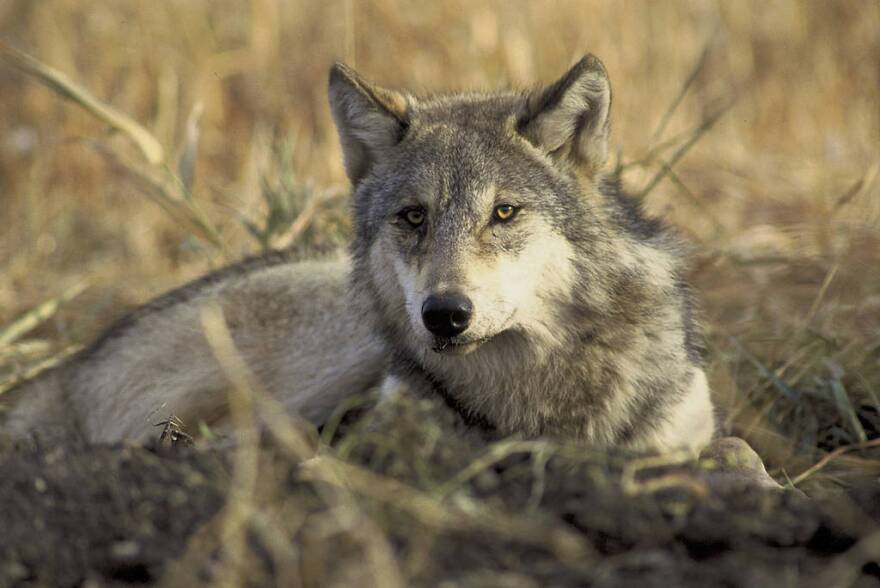Colorado’s last wild wolves were killed in the 1930s, but this winter, wildlife officials confirmed that a wolf pack has moved in to Northwest Colorado. The news comes several months before Colorado voters decide whether they’ll support a bill to reintroduce gray wolves to the state. Recent reporting from Aspen Journalism looks into what the return of wolves could mean for the Roaring Fork valley. Morning Editon host and reporter Molly Dove sat down with Aspen Journalism Environment Editor Elizabeth Stewart-Severy.
Tell us a little more about the wolves who have moved into northwest Colorado; what significance does this pack have?
The rural northwest corner of the state is well-suited for wolves. There’s good habitat, lots of prey, and few humans.
Wolf advocates are careful to point out that this does not mean there is a sustainable population of wolves in Colorado. Delia Malone lives in Carbondale and works with the advocacy group, the Rocky Mountain Wolf Project.
“A sustainable, recovered population is a population that is ecologically effective in their role to restore natural balance; they’re well-distributed throughout Colorado; they’re well-connected,” Malone said. “And six little wolves is not that.”
Malone is still working hard to advocate for the ballot initiative that would reintroduce wolves — she says Colorado’s ecosystems need wolves.
Why is that?
In short, the combination of a warming climate and lack of predators has reduced the resilience of Colorado’s aspen forests and other habitats.
Wolves force elk herds to move around more so that they don’t overgraze, which helps forests recover. That allows other animals to use those forests — particularly beavers, who then can build dams and help store water for later in the summer when streamflows are lowest.
Malone and other supporters say Initiative 107 is the most reliable way to ensure that wolves are able to return to Colorado and thrive.
If that initiative passes, would the reintroduction be close to Aspen?
The Rocky Mountain Wolf Project identified several key places where they think wolves would do well — remote areas with lots of prey species and few humans.
The Flat Tops Wilderness, which is north of Glenwood Springs, and the Grand Mesa are both on that list.
Are local ranchers concerned about wolves coming back to the area?
Yes, all the ranchers I spoke with think wolves will mean significant changes to their operations.
I spoke with Bill Fales and Marj Perry, who have been ranching near Carbondale for decades, and they worry that wolves will eat their cattle, especially while their herd is grazing on National Forest Service land in the late summer.
Wolf advocates and ranchers in states with wolves - like Montana - say there are ways to protect livestock by training the cattle to gather in herds to protect the weakest members.
But Fales and Perry say where their cattle graze, that just isn’t possible. There aren’t large open areas for all the cattle to herd up, and they say other techniques — like having range riders who watch for wolves — aren’t financially feasible. They say they might quit if the ballot initiative passes.
Other ranchers, like Jose Miranda, who raises water buffalo in Old Snowmass, say they will vote for reintroduction. Miranda says the water buffalo have the herd instinct intact, so he thinks they’ll do better against wolves, and he says, it’s just the morally correct thing to do to return wolves to their native area.
In other states, do wolves kill livestock at high numbers?
Everyone I spoke with agrees that wolves do kill cattle and some sheep, but the numbers are — perhaps surprisingly — low. In 2018, in each Montana and Wyoming, wolves killed 71 head of livestock, mostly cattle. There are 2.5 million cows in Montana, so the percentage is really low.
Still, ranching in this area is tough and getting tougher. Perry and Fales say the economics are so tight that any losses are significant, and Perry pointed out that it’s emotional too:
"There's an emotional attachment (to the cattle), even though you're selling them for a beef animal,” Perry said. “You're taking care of them, we're with them just night and day when they're calving. And to go out and find them just shredded and eaten up is not something I would ever vote for.”
So, while experts say there are ways to protect your cattle, that risk of loss looms large for some people here.
Aspen Journalism collaborates with Aspen Public Radio and The Aspen Times on coverage of biodiversity and the environment. More at aspenjournalism.org.



